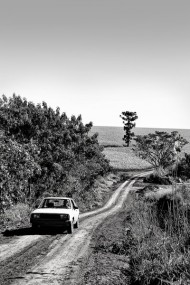Swaggie on the road
czyli o figurze nomady w literaturze XIX-wiecznej Australii

Australia to kontynent bezkresnych przestrzeni i jako taki stanowił dla chcącego go przemierzyć człowieka ogromne wyzwanie, co nie zmieniło się zresztą do dziś. Australijski outback nie bez podstaw kojarzy się z wolnością i swobodą, ale z drugiej strony często bywał dla rzucających mu wyzwanie śmiałków przeciwnikiem nie do pokonania. Obecnie ponad osiemdziesiąt procent Australijczyków mieszka w dużych miastach ciągnących się wzdłuż wybrzeży kontynentu. I choć ludzie ci nie mają na co dzień nic wspólnego z interiorem środkowych części kraju, to jednak outback był i jest nadal esencją australijskości, która jednoczy dwudziestomilionowy naród. Przeciętny Australijczyk pielęgnuje w sobie sprzeczność: wiedzie wygodne życie mieszczucha, który na oczy nie widział odludzi wewnątrz kraju oraz niewiele wie o jego bogatej przyrodzie, a jednocześnie czuje się potomkiem postaci z XIX-wiecznych ballad narodowego wieszcza Australii A.B. „Banjo” Patersona, który wykreował w swej twórczości postaci małomównych, zahartowanych przez naturę włóczykijów.
(...) Piosenkę o wygłodzonym wędrownym robotniku, czyli właśnie swagmanie, który przyłapany na kradzieży owieczki woli śmierć niż utratę wolności, znają zarówno farmerzy pracujący wewnątrz kontynentu, jak i miastowi ockerzy.
Abstract
Swaggie on the Road. A Figure of Nomad in 19th Century Australian Literature
Australian interior has always been the great challenge for its explorers. Australian outback is associated with freedom, yet it turns out to be an insurmountable opponent for daredevils in traditional culture. It is the nucleus of national identity and the most important national symbols are the figures of squatters, nomad sheep shears, diggers, bushrangers and tramps, who are called swagmen or swaggies.
A figure of swaggie appeared for the first time in 19th century in Australian folk songs and tales. On the basis of this folk oral art activity Australian poets and writers created their own short novels and ballads, in which they pictured a modest and simple – but still full of adventures – life of men travelling trough infinities of Australian land. The yearning for freedom and adventure can be found in the novels by Rolf Boldrewood. The most popular Australian song Waltzing Matilda by national poet Andrew Barton “Banjo” Paterson recalls a story of a poor swaggie, who prefers to die than go to jail.
Even today enormous Australian space inspires many writers, artists and directors. They use motives of travelers, wanderers or fugitives. Films such as Walkabout by Nicolas Roeg, Spider and Rose by Bill Bennet, Priscilla by Stephan Elliot or Siam Sunset by John Polson can be considered a variation of American road movie, but they also include some very “Australian” threads. Protagonist in such film are based on the figure of the 19th century swaggie who, being uncertain of tomorrow, is getting power out of the promise of adventure.


